Order: Piciformes
Family: Picidae
Genus: Picoides
Species: Picoides villosus
Introduction
A Male Hairy Woodpecker. By Alan D. Wilson,www.naturespicsonline.com [CC-BY-SA-2.5], via Wikimedia Commons
The Hairy Woodpecker, or Picoides villosus is a medium sized woodpecker with a habitat range spanning over a majority of the United States and up into Southern Canada. They have black, white and grey plumage; then in addition, the males have a recognizable red patch just above their nape to the top of their head. They also have a white streak down their backs, while their wings are spotted with white.
The Hairy Woodpecker is easily mistaken for it’s smaller relative the Downy Woodpecker, as they are almost identical in appearance except for size; the Hairy is larger than the Downy. The Hairy’s bill is also longer than the Downy Woodpecker’s (Sibley 2003).
By Grantus4504 (Own work)
[CC-BY-SA-3.0 or GFDL], via Wikimedia Commons
Figure 1.
Jackson, Jerome A., Henri R. Ouellet and Bette J. Jackson. 2002
Rattle: A Hairy Woodpecker’s rattle is loud series of quick, high pitched uniform sounds: jer jer jer jer… (Kilham 1966).
Drumming: Hairy Woodpeckers drum all year long; there drum is made up of very fast and long repeated knocks. Both sexes will drum to defend territory, as part of courtship, and as a warning sign of intruders near a nest. (Kilham 1966)
(Donald Kroodsma 2005)
Tapping: Hairy Woodpeckers make a slightly deep tapping sound that sounds similar to an extra slowed down version of their drum. This occurs while they are foraging for insects.
-Flight: The Hairy Woodpecker is an intermittent flier, which flaps then bounds and repeats. Its bounds are often for a long duration (Tobalske 1996).
-Climbing: Woodpeckers use their long curved talons and stiff tail-feathers to help propel themselves up trees. They have a specific way of climbing: First they use their tail to push themselves upwards while leaning in close to the tree, and then throw themselves up with their legs before grabbing onto the tree again and stabilizing themselves with their tail. (Sibley 2003)
Mating Behavior:
During courtship, the male will make sputtering calls, and then will raise their red crown and spread his tail showing his white outer retrices. (Grinnell & Storer 1924, Lawrence 1967). Males will usually approach a female by climbing the tree to her, instead of flying and then they follow each other through the trees (Jackson & Quillet 2002). Mating occurs after the female consents the male with a “twittering call” (Kilham 1974). Hairy Woodpeckers are monogamous and their pair bonds last year round, occasionally for a lifetime (Kilham 1966). These breeding pairs form in late winter (Atkinson).
Christmas Bird Count Data Nationwide
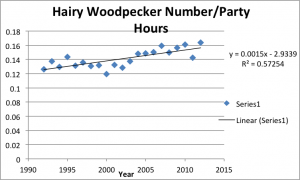
This graph displays Christmas Bird Count data nationwide for Hairy woodpeckers from 1992-2012. P value=<.0001
Christmas Bird Count Data Statewide (WA)
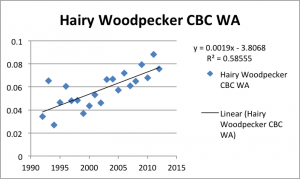
This graph displays Christmas Bird Count data statewide (WA) for Hairy woodpeckers from 1992-2012. P value=<.0001
The overall trends from the Nationwide and statewide Christmas Bird Counts show a slow and semi-scattered increase in population size from the year 1992 to 2012. the P values from each of these CBC graphs indicate that there is actually an increasing trend in population size between the set dates.
Breeding Bird Survey Data Nationwide
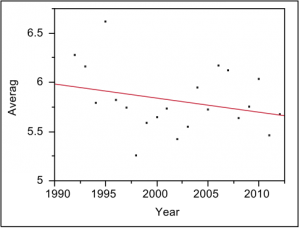
This graph displays Breeding Bird Survey Data on Hairy woodpecker from 1992-2012. The BBS nationwide data is scattered with a P value of 0.22 indicating no strong trends in negative population changes
Breeding Bird Survey Data Statewide (WA)
I noticed something particular about the habits of woodpeckers foraging through my observations. They have a pattern of probing and then attacking. There are usually a specific number of probes before the woodpecker obtains food then pulls their head back and eats. The probe as I see it is like a searching mechanism for the food.
11/18/14
It was around 45 degrees F outside and seventy percent of the sky was covered in clouds. In the Evergreen State college woods there is a narrow boardwalk; while I was walking along it I heard a slight tapping sound to the right of me, it was a woodpecker. This is the sound I was looking for, after scanning the trunks for movement I found a male Hairy Woodpecker pecking at the side of a tree. Another woodpecker had previously used this tree, as I could see it had some holes in the trunk. The Hairy was around six meters high; I was using my own height to measure. He climbed to a branch and began pecking upward, then flew to the trunk of the tree and started to peck at the holes. More detailed information is displayed in Figure 1.
In the same day I spent time observing and walking through the Organic farm trail behind Lab II. Halfway through the trail towards the farm I heard the tapping of a woodpecker once again. So I followed it by ear into the dense fern-filled forest. I got about twenty-five feet away from the Hairy Woodpecker and started to hear another on my other side. At that point I started taking notes on its probing and attacking, which are presented below in Figure 1. but after observing for about twenty minutes the woodpecker flew away. Then the other woodpecker took off as well, adding a loud Peek sound. This was the first time I had heard their call.
| Location | Species | Maneuver Specific | ManeuverBroad | Substrate typeSpecific | Substrate | Height above |
| TESC Forest* | Picoides Villosus | 3 Attacks | Hanging under | Branch | Branch | 6m |
| TESC Forest* | Picoides Villosus | Probe | From above | In holes | Trunk | 6m |
| TESC Forest* | Picoides Villosus | 2 Attacks | On side | Wide branch | Branch | 6.5m |
| TESC Forest* | Picoides Villosus | Attack | Hanging under | Thin branch | branch | 4m |
| Organic farm# | Picoides Villosus | Probe | On side | Douglas fir | Trunk/Canopy | 3m |
| Organic farm# | Picoides Villosus | 3 Attacks | On side | Douglas fir | Trunk/Canopy | 4m |
| Organic farm# | Picoides Villosus | 2 attacks | On side | Douglas fir | Trunk/Canopy | 4m |
Figure 1.
*F -lot woods of the Evergreen State College forest
# -Organic Farm trail from back of Lab II of the Evergreen State College down to the organic farm, towards the middle/on the side of the Longhouse
11/24
| Location | Species | Maneuver Specific | ManeuverBroad | Substrate typeSpecific | Substrate | Height above |
| Organic Farm | Picoides Villosus | 3 Probes | On side | Douglas fir | Trunk | 4m |
| Organic Farm | Picoides Villosus | 2 Probes | On side | Douglas fir | Trunk | 4m |
| Organic Farm | Picoides Villosus | Climbs upward | – | Douglas fir | Branch | 4.5m |
| Organic Farm | Picoides Villosus | Attack | Reaching to side | Douglas fir | Branch | 5m |
| Organic Farm | Picoides Villosus | 3 Probes | On side | Douglas fir | Trunk | 5m |
| Organic Farm | Picoides Villosus | Attack | On side | Douglas fir | Trunk | 5.5m |
Figure 2.
11/30
| Location | Species | Maneuver Specific | ManeuverBroad | Substrate typeSpecific | Substrate | Height above |
| Forest* | Picoides Villosus | 4 Probes | On side | Trunk | Trunk | 3m |
| Forest* | Picoides Villosus | Flies upward | – | Trunk | Trunk | 3m |
| Forest* | Picoides Villosus | Attack | Moves to branch | Branch | Branch | 3.5m |
| Forest* | Picoides Villosus | 3 Probes | Reaching downward | Branch | Branch | 3.5m |
Figure 3.
*Across the street from the Evergreen Organic Farm
12/2
Back again in the Evergreen State College forest I walked past the boardwalk with me head clear and my ears ready. Suddenly I heard a screech, which I first thought must be a woodpecker. So I listened closer, but didn’t hear anything. I kept walking, and then heard a deep tapping, which was most definitely a woodpecker. So I ventured out into the forest. I had my shotgun microphone in my left hand and my Olympus LS-100 in my right, ready to record. When I finally found the woodpecker and started recording I noticed how large it was, at least a foot tall! Turns out that it wasn’t a Hairy Woodpecker but instead a pileated. I recorded and then kept on walking. Coming close to the beach without hearing another Woodpecker I started to lose hope. But once I had arrived at the beach I got to enjoy the surf scooters. On my way back up the trail I was surprised with by the sound of a woodpecker tapping. It was a male Hairy Woodpecker up at least six meters high on the mid section of a Douglas fir. Every two to three seconds it would peck at the tree, sometimes finding an insect to eat. Most of the pecks he made towards the tree were just probing or searching. A couple minutes into my observations the Hairy started making sounds, which were hard to pick up even by my shotgun microphone. They were not very loud and very short calls: peech peech peech. I couldn’t tell why he was making them; it could have been that he noticed me as a sort of threat. He stayed on the main trunk of the tree for thirty minutes, and then I continued on the path up back through the forest and found a Downy on the way. I stopped multiple times on the boardwalk to see if I could hear another woodpecker, but I couldn’t. Then just towards the exit of the forest and into the parking lot entrance was another Hairy Woodpecker, which flew to another tree shorty after I had made the note into my microphone.
12/3
It was around thirty-five degrees and there was still frost on the ground in the Evergreen State College forest I was looking for a woodpecker specifically for recording. I heard tapping once I was deep into the forest taking a new trail. Recorded two calls but noticed a difference, it was a Red-Breasted Sapsucker. Then a large bird flew overhead, and I heard it moments later: a Barred Owl. Farther down the path near a hut built by students I spotted a Hairy. Figure 4. Displays my recordings.
| Location | Species | Maneuver Specific | ManeuverBroad | Substrate typeSpecific | Substrate | Height above |
| TESC Forest | Picoides Villosus | 3 Probe | On side | Trunk | Douglas fir | 6m |
| TESC Forest | Picoides Villosus | Attack | On side | Trunk | Douglas fir | 6m |
| TESC Forest | Picoides Villosus | Moves clockwise | – | Trunk | Douglas fir | 6m |
| TESC Forest | Picoides Villosus | 3 Probes | On side | Trunk | Douglas fir | 6m |
| TESC Forest | Picoides Villosus | Moves to branch | – | Thick Branch | Douglas fir | 6m |
| TESC Forest | Picoides Villosus | Flies to new tree | – | Trunk of new tree | Trunk | 3m |
| TESC Forest | Picoides Villosus | 2 Probes | On side | Trunk | Trunk | 3m |
| TESC Forest | Picoides Villosus | Attack | On side | Trunk | Trunk | 3m |
| TESC Forest | Picoides Villosus | 4 Probes | Moves to branch | Thick Branch | Branch | 3m |
| TESC Forest | Picoides Villosus | 2 Probes | Reaching down | Thick Branch | Branch | 3m |
| TESC Forest | Picoides Villosus | Attack | Moves to Side | Trunk | Trunk | 3m |
| TESC Forest | Picoides Villosus | Flies downward | – | Trunk | Trunk | 2.5m |
| TESC Forest | Picoides Villosus | 5 Probes | On side | Trunk | Trunk | 2.5m |
| TESC Forest | Picoides Villosus | 2 Probes | On side | Trunk | Trunk | 3m |
| TESC Forest | Picoides Villosus | Attack | On side | Trunk | Trunk | 3m |
| TESC Forest | Picoides Villosus | Moves to other side of tree | Counter clockwise | Trunk | Trunk | 4m |
| TESC Forest | Picoides Villosus | Attack | On side | Trunk | Trunk | 4m |
| TESC Forest | Picoides Villosus | Flies to Branch | – | Branch | Branch | 4m |
| TESC Forest | Picoides Villosus | 2 Attacks | Reaching up from below | Branch | Branch | 4m |
Figure 4.
Jackson, Jerome A., Henri R. Ouellet and Bette J. Jackson. 2002. Hairy Woodpecker (Picoidesvillosus), The Birds of North America Online (A. Poole, Ed.). Ithaca: Cornell Lab of Ornithology; Retrieved from the Birds of North America Online: http://0-bna.birds.cornell.edu.cals.evergreen.edu/bna/species/702
Lawrence, L. de K. 1967. A comparative life history study of four species of woodpeckers. Ornithol. Monogr. 5:1-156.
Grinnell, J. and T. I. Storer. 1924. Animal life in the Yosemite. Univ. of California Press, Berkeley.
Kisiel, D. S. 1972. Foraging behavior of Dendrocopos villosus and D. pubescens in eastern New York State. Condor 74:393-398.
Farris, K.L., & Zack, S. 2005. Woodpecker snag interactions: an overview of current knowledge in ponderosa pine systems. USDA Forest Service General Technical Report 183-195
Jackman, S.M. 1975. Woopeckers of the Pacific Northwest: their characteristics and their role in the forests. M.S. thesis. Oregon State University, Corvallis 147p.
A. G. van Aken The American Naturalist, Vol. 17, No. 5 (May, 1883), pp. 511-515
Dana Ripper, James C. Bednarz, Daniel E. Varland. Landscape Use by Hairy Woodpeckers in Managed Forests of Northwestern Washington. The Journal of Wildlife Management, Vol. 71, No. 8 (Nov., 2007), pp. 2612-2623
John Klicka, Garth M. Spellman, Kevin Winker, Vivien Chua, and Brian T. Smith (2011) A Phylogeographic and Population Genetic Analysis of a Widespread, Sedentary North American Bird: The Hairy Woodpecker (Picoides villosus). The Auk: April 2011, Vol. 128, No. 2, pp. 346-362.
Lawrence Kilham The Wilson Bulletin, Vol. 77, No. 2 (Jun., 1965), Differences in Feeding Behavior of Male and Female Hairy Woodpeckers. pp. 134-145
Kilham L. 1966 Reproductive behavior of Hairy Woodpeckers. 1. Pair formation and courtship Vol. 78 pp. 251-265
Kale, H. W., II, B. Pranty, B. M. Stith, and C. W. Biggs. 1992. The atlas of the breeding birds of Florida. Final Report. Florida Game an Fresh Water Fish Commission, Tallahassee, Florida.
Donald Kroodsma, 2005 “The Singing Life Of Birds”
Sibley D. A. 2003 The Sibley: Field Guide to Birds of Western North America. Pp.268-269
Atkinson, Scott, Brain Bell, and Julia Bent. “Hairy Woodpecker.” BirdWeb. Seattle Audubon Society, n.d. Web. 07 Dec. 2014.

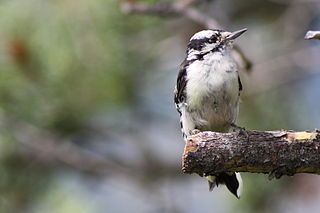
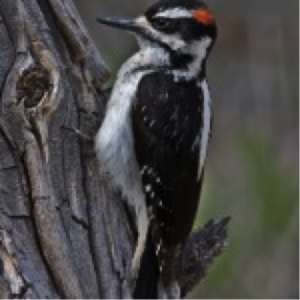
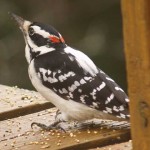
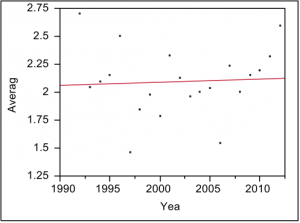
Leave a Reply